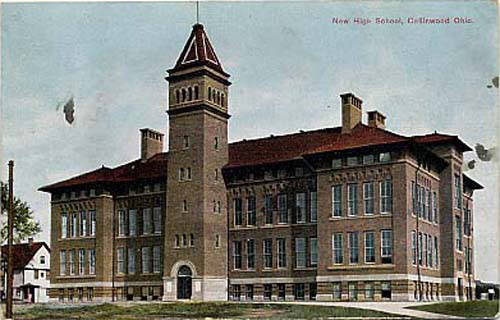Collinwood High School

In 1874, a single rail stop was constructed about ten miles east of downtown Cleveland, allowing incoming trains to switch engines before entering the city. The operation quickly grew to accommodate hundreds of trains, with thousands of workers to form a thriving manufacturing and residential neighborhood. Today, Collinwood remains a blue collar community, with deep ties to the old railyard. Collinwood High School, home of the Railroaders, has served this working community since 1907.
Cleveland, Ohio's northeast corner grew from a railroad stop in the mid 1800's to a vibrant community by the turn of the century. Few people resided in the area until the Lake Shore and Michigan Southern Railroad developed a line to Painesville and Ashtabula and placed stop number 11 in "Frogsville," a swampy area about ten miles northeast of the mouth of the Cuyahoga River along the Lake Erie shoreline. By 1863 twenty families lived in the area bounded by Collamer Village to the south and Nottingham Village to the east. The railroad stop grew from a place to switch engines to enter the central city to a multi-purpose maintenance and railroad switching operation. The railroad expansion in the area brought more population and by 1876, the railroad’s well regarded chief engineer, John Collins gave his name to the settlement. By 1899 the Directory of Collinwood listed its population at 3,237 residents.
At the turn of the twentieth century the community was responding to a growing need for schools. Originally a one room building on Collamer Avenue (now East 152 Street) and Waterloo Road served the neighborhood children. By 1864, a second red brick school was added serving all grades until 1889. That year, Clark School was built at Saint Clair Avenue and Clark Street (East 147 Street) to accommodate the growing student population. In 1892, Clark High School graduated its first class – one senior.
Frank P. Whitney, a recent Oberlin College graduate, was hired as principal for 90 students at Clark. Frank grew up on a farm in Huron, Ohio, and spent two years teaching in the rural village of Wakeman. Following his first year at Collinwood, he rode his bicycle to New York City, boarded a steamer for England and explored English schools via bicycle for the summer. Upon his return he was appointed to lead Collinwood's schools as superintendent where he began to install programs inspired by his visit to English schools.
During this same period, Cleveland experienced its initial wave of central and southern European immigrants arriving to work, live, and settle in ethnic enclaves throughout the city. Collinwood also experienced this phenomenon. The railroad line bisected the village and provided a valuable resource for factory development and transportation access. Areas north and south of the tracks afforded plenty of land to develop residential housing for the immigrant workers. Manufacturers sought inexpensive land adjacent to the rail lines and attracted the needed human resources, first from Cleveland to the west, and later more European immigrants into the developing neighborhood. The abundant construction and factory-style work suited the people who populated the region. The neighborhood mix of residential and industrial space defined the community’s character, it blended the immigrant workforce with the manufacturing boom. Several large corporations established factories to support Cleveland’s manufacturing leadership that emerged during the end of the nineteenth century and the first half of the twentieth century.
Meanwhile, more students required more space. In 1907, South High School was dedicated on the site where Collinwood High School now stands. During that year, a tragic fire at Lakeview School took the lives of 172 students and two teachers. Cleveland annexed Collinwood Village and its schools were added to the Cleveland Public Schools in 1910. Mr. Whitney joined the school district as principal (West Tech), supervisor, and assistant superintendent before returning to his Collinwood "home" in 1926 as principal of the newly built Collinwood High School. During its first year, enrollment reached 3,488 students, Ohio’s largest school at the time. In less than thirty years, the school enrollment alone exceeded the neighborhood's entire resident population.
The neighborhood reached its highest population census between 1930 and 1960. Whitney's influence continued with his leadership through 1941 as the high school thrived with high enrollments, dedicated faculty, and nationally recognized programs featuring health, citizenship, and character education and student guidance. "Railroader" football teams of the 1940s and Lady Railroader track teams of a more recent era, excelled on the track and in the classroom. Honors academics joined numerous extra curricular programs to provide students with Cleveland’s best educational opportunities throughout the new century.
Collinwood continued to reflect developments of the larger Cleveland community. By the 1960s and 1970s, racial strife at the high school reflected community tensions. Its mix of people, manufacturing employers, schools, and social climate reflected the rise and fall story of the rust belt urban center and its school challenges.
Audio
Images


clevelandmemory.org Date: March, 1912





